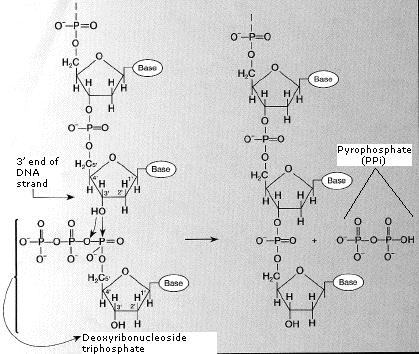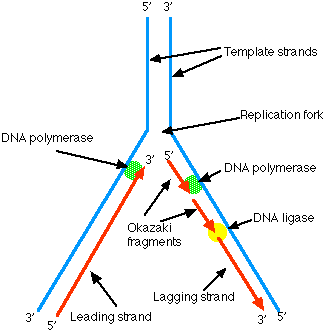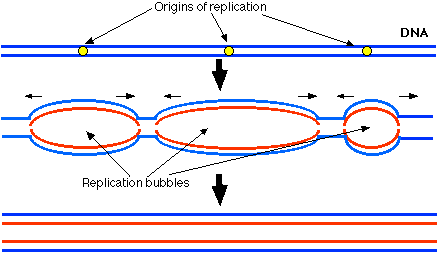| Index to this page |
Before a cell can divide, it must duplicate all its DNA. In eukaryotes, this occurs during S phase of the cell cycle.


Watson and Crick had suggested that this was the way the DNA would turn out to be replicated. Proof of the model came from the experiments of Meselson and Stahl. [Link to them.]
The single molecule of DNA that is the E. coli genome contains 4.7 x 106 nucleotide pairs. DNA replication begins at a single, fixed location in this molecule, the replication origin, proceeds at about 1000 nucleotides per second, and thus is done in no more than 40 minutes. And thanks to the precision of the process (which includes a "proof-reading" function), the job is done with only about one incorrect nucleotide for every 109 nucleotides inserted. In other words, more often than not, the E. coli genome (4.7 x 106) is copied without error!

The average human chromosome contains 150 x 106 nucleotide pairs which are copied at about 50 base pairs per second. The process would take a month (rather than the hour it actually does) but for the fact that there are thousands of places on the eukaryotic chromosome, called origins of replication, where replication can begin and then proceed in both directions. Replication begins at some replication origins earlier in S phase than at others, but the process is completed for all by the end of S phase. As replication nears completion, "bubbles" of newly replicated DNA meet and fuse, finally forming two new molecules.
With their multiple origins, how does the eukaryotic cell know which origins have been already replicated and which still await replication?
An observation: When a cell in G2 of the cell cycle is fused with a cell in S phase, the DNA of the G2 nucleus does not begin replicating again even though replication is proceeding normally in the S-phase nucleus. Not until mitosis is completed, can freshly-synthesized DNA be replicated again.
Two control mechanisms have been identified — one positive and one negative. This redundancy probably reflects the crucial importance of precise replication to the integrity of the genome.
 In order to be replicated, each origin of replication must be bound by:
In order to be replicated, each origin of replication must be bound by:
Once replication begins in S phase,
G2 nuclei also contain at least one protein — called geminin — that prevents assembly of MCM proteins on freshly-synthesized DNA (probably by blocking the actions of Cdt1).
As the cell completes mitosis, geminin is degraded so the DNA of the two daughter cells will be able to respond to licensing factors and be able to replicate their DNA at the next S phase.
| Some cells deliberately cut the cell cycle short allowing repeated S phases without completing mitosis and/or cytokinesis. This is called endoreplication. How these cells regulate the factors that normally prevent DNA replication if mitosis has not occurred is still being studied. Endoreplication is described on a separate page. Link to it. |
| Welcome&Next Search |